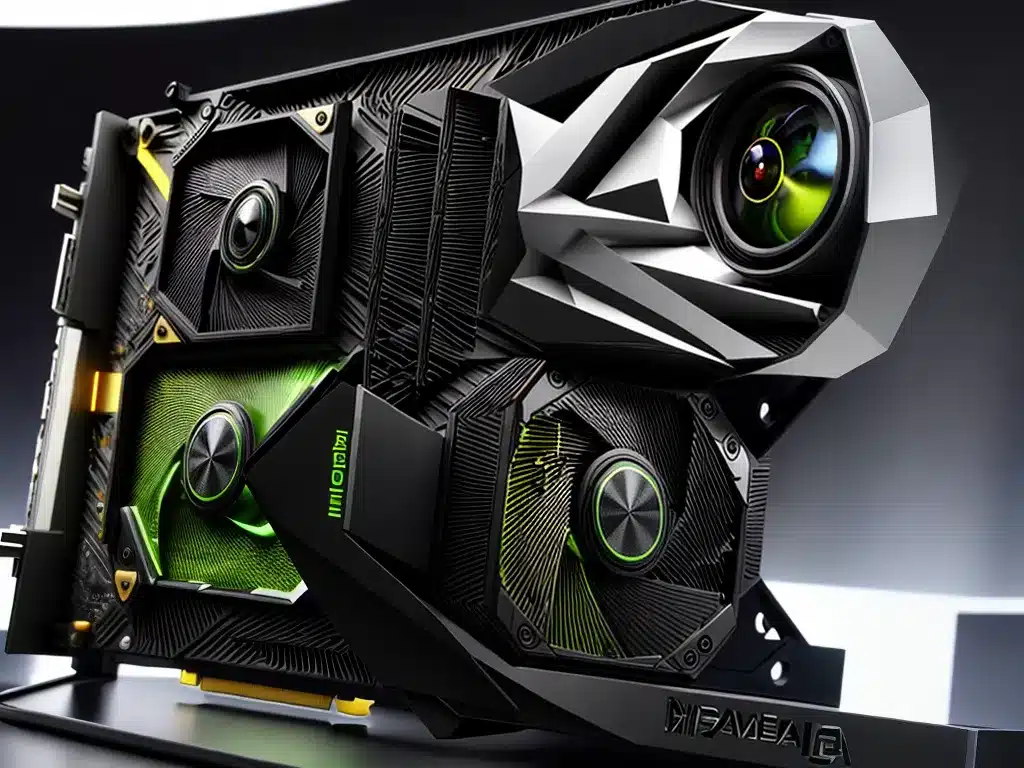
Nvidia is a leading company in developing graphics processing units (GPUs) and leveraging artificial intelligence (AI) to improve graphics performance. Here’s an in-depth look at how Nvidia uses AI in their GeForce graphics cards to boost image quality and frame rates in games.
DLSS (Deep Learning Super Sampling)
Nvidia’s Deep Learning Super Sampling (DLSS) technology uses AI to boost frame rates and generate sharper images in games.
How DLSS Works
DLSS relies on an AI neural network trained on thousands of game images. This deep learning model uses an image rendering algorithm to take lower resolution images and upscale them to higher resolutions while preserving detail.
-
The game initially renders at a lower resolution. This lowers the processing demand on the GPU and increases frame rates.
-
The low resolution image is passed to the DLSS AI model.
-
The AI uses its deep learning algorithms to infer data missing from the lower resolution image. It analyzes game textures, edges, surfaces and other details to reconstruct a higher resolution image.
-
This AI-enhanced higher resolution image is then displayed on the gamer’s screen. The end result is improved image quality over native resolution rendering, while maintaining high performance and frame rates.
DLSS Provides Multiple Image Quality Modes
DLSS offers game developers different modes to balance image quality and performance:
-
Performance mode – Renders at the lowest target resolution but provides the highest frame rates.
-
Balanced mode – Offers a good balance between visual quality and high frame rates.
-
Quality mode – Renders at a higher target resolution to prioritize image quality while still improving performance over native resolution rendering.
Nvidia RTXGI – Real-Time Ray Traced Global Illumination
Nvidia RTXGI uses AI and ray tracing to realistically simulate how light interacts with game environments. This provides significantly improved lighting quality and realism.
How Nvidia RTXGI Works
-
RTXGI uses ray tracing to accurately calculate how light rays propagate, reflect, refract and interact with surfaces. This captures real-world accurate lighting.
-
An AI denoising algorithm removes noise inherent in ray tracing. This allows RTXGI to run efficiently in real-time without excessive noise.
-
The AI model intelligently filters and reconstructs the image to add detail back. This cleans up noise while preserving scene lighting and reflections.
-
RTXGI generates dynamic real-time global illumination. As characters move through the game environment, lighting constantly adapts and recalculates based on their perspective. This creates incredibly realistic and responsive lighting.
Benefits of Nvidia RTXGI
-
Significantly more natural and accurate lighting and reflections.
-
Improved depth, shadows, and nuanced details from ray traced lighting physics.
-
Performance optimized from AI denoising so RTXGI can operate in real-time.
Nvidia DLAA (Deep Learning Anti-Aliasing)
DLAA utilizes AI deep learning to combat jagged edges (aliasing) in games, providing smoother and cleaner visuals.
How DLAA Improves Anti-Aliasing
-
DLAA AI examines the full image to identify patterns and edges causing aliasing artifacts.
-
It applies selective filters only to the parts of the image needing anti-aliasing. This minimizes blurring that traditional anti-aliasing causes.
-
The AI model sharpens details like hair and foliage after applying anti-aliasing. This restores lost detail from regular anti-aliasing.
-
DLAA AI algorithms are trained on samples from specific games. This allows it to optimize anti-aliasing quality on a per-game basis.
Advantages of Nvidia DLAA
-
Significantly reduced aliasing for smoother edges and gradients.
-
Minimal impact on texture detail compared to other anti-aliasing methods.
-
Faster performance than supersampling anti-aliasing.
-
Custom optimized for maximum image quality in each supported game.
Conclusion
Nvidia integrates AI and deep learning across their graphics pipeline to boost image quality through upscaling, improved lighting, and anti-aliasing. AI optimization also allows these graphics enhancements to operate in real-time while maximizing frame rates. These innovations demonstrate how AI can push graphics technology to new heights. Gamers benefit from more immersive visuals and higher fidelity graphics thanks to Nvidia’s AI leadership.












